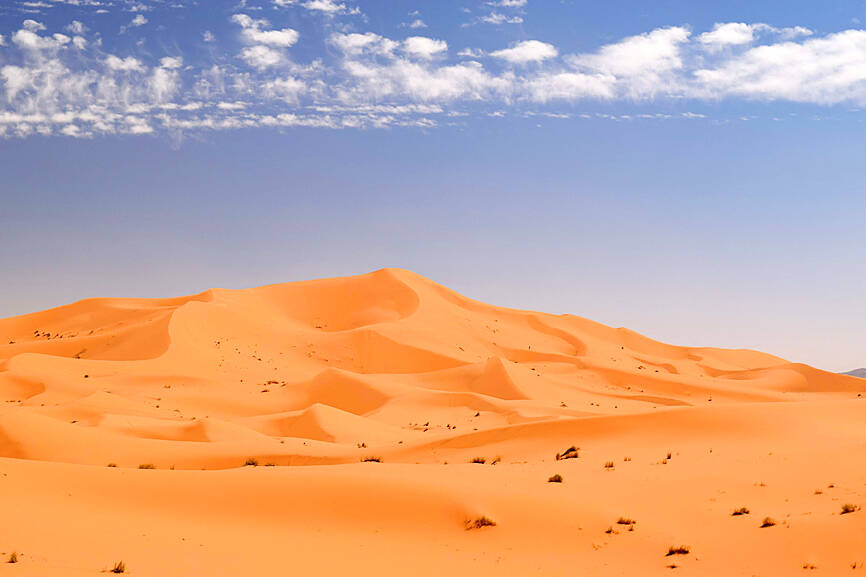They are among the wonders of our deserts: star dunes, the vaguely pyramid-shaped sand formations up to about 300m tall with arms stretching out from a central peak to give them a star-like appearance when viewed from above.
Scientists yesterday unveiled the first in-depth study of a star dune, revealing the internal structure of these geological features and showing how long it took for one of them to form — more quickly than expected, but still a process unfolding over many centuries.
The study focused upon a star dune in eastern Morocco called Lala Lallia, meaning “highest sacred point” in the Berber language, situated within the Sahara in a small sand sea called Erg Chebbi about 5km from the town of Merzouga, close to the border with Algeria.

Photo: Reuters
Lala Lallia rises about 100m above the surrounding dunes and is approximately 700m wide, containing about 5.5 million tonnes of sand.
The researchers used ground-penetrating radar to peer inside the dune and employed luminescence dating to determine how long Lala Lallia has taken to form, a method based on the amount of energy trapped inside the grains of sand.
The answer: about 900 years, accumulating roughly 6,400 tonnes annually as wind relentlessly blows sand through the desert.
Star dunes make up just under 10 percent of the dunes in Earth’s deserts and are the tallest ones, surpassing other types such as crescent-shaped barchan dunes and straight and lengthy linear dunes. They have also been spotted on Mars and on Saturn’s large moon Titan.
“I first encountered star dunes in Namibia 20 years ago, and was instantly amazed at the size of them. I have a vivid memory of the long climb to the top, struggling up very loose sand in the heat of the day,” said geographer Geoff Duller of Aberystwyth University in Wales, coauthor of the study published in the journal Scientific Reports.
“I find desert dunes very beautiful,” Duller added. “The sight of the sinuous curves, and the way that the light and shadow changes with the sun mean that they always look different, whether that is in the cool of the morning, the midday sun or near sunset. The different colors of sand in different deserts are also very striking, with yellow, white, red and even black dunes in different parts of the world.”
The ground-penetrating radar revealed the layers within the Lala Lallia dune, showing how it was constructed over time through accumulating sand and how parts of its internal structure resembled other types of dunes.
“Star dunes are formed in areas with complex wind regimes, which means winds blowing from different directions, and net sand accumulation, points within the desert where big piles of sand can be blown around to form giant dunes,” Birkbeck University of London sedimentologist and study co-author Charlie Bristow said.
The researchers also determined that Lala Lallia is moving westerly at about 0.5m annually.
While many star dunes are known today, only a single ancient one has been found preserved as sandstone in the geological record, dating to about 250 million years ago, in Scotland.
By revealing their internal structure, the researchers said their findings provide a guide for geologists to identify more sandstone remnants of ancient star dunes.
Earth’s largest star dunes are found in the Badain Jaran desert in western China. Star dunes are also found in places including the Namib Sand Sea in Namibia, large sand seas in Algeria such as the Grand Erg Oriental and Grand Erg Occidental, and Rub’ al Khali in Saudi Arabia. In North America, Great Sand Dunes National Park in Colorado contains a series of them.
“They form extraordinary and awe-inspiring landscapes,” Bristow said. “From the ground they can be intimidating, mobile mountains of sand.”

FRAUD ALLEGED: The leader of an opposition alliance made allegations of electoral irregularities and called for a protest in Tirana as European leaders are to meet Albanian Prime Minister Edi Rama’s Socialist Party scored a large victory in parliamentary elections, securing him his fourth term, official results showed late on Tuesday. The Socialist Party won 52.1 percent of the vote on Sunday compared with 34.2 percent for an alliance of opposition parties led by his main rival Sali Berisha, according to results released by the Albanian Central Election Commission. Diaspora votes have yet to be counted, but according to initial results, Rama was also leading there. According to projections, the Socialist Party could have more lawmakers than in 2021 elections. At the time, it won 74 seats in the

EUROPEAN FUTURE? Albanian Prime Minister Edi Rama says only he could secure EU membership, but challenges remain in dealing with corruption and a brain drain Albanian Prime Minister Edi Rama seeks to win an unprecedented fourth term, pledging to finally take the country into the EU and turn it into a hot tourist destination with some help from the Trump family. The artist-turned-politician has been pitching Albania as a trendy coastal destination, which has helped to drive up tourism arrivals to a record 11 million last year. US President Donald Trump’s son-in-law, Jared Kushner, also joined in the rush, pledging to invest US$1.4 billion to turn a largely deserted island into a luxurious getaway. Rama is expected to win another term after yesterday’s vote. The vote would

CANCER: Jose Mujica earned the moniker ‘world’s poorest president’ for giving away much of his salary and living a simple life on his farm, with his wife and dog Tributes poured in on Tuesday from across Latin America following the death of former Uruguayan president Jose “Pepe” Mujica, an ex-guerrilla fighter revered by the left for his humility and progressive politics. He was 89. Mujica, who spent a dozen years behind bars for revolutionary activity, lost his battle against cancer after announcing in January that the disease had spread and he would stop treatment. “With deep sorrow, we announce the passing of our comrade Pepe Mujica. President, activist, guide and leader. We will miss you greatly, old friend,” Uruguayan President Yamandu Orsi wrote on X. “Pepe, eternal,” a cyclist shouted out minutes later,

A Croatian town has come up with a novel solution to solve the issue of working parents when there are no public childcare spaces available: pay grandparents to do it. Samobor, near the capital, Zagreb, has become the first in the country to run a “Grandmother-Grandfather Service,” which pays 360 euros (US$400) a month per child. The scheme allows grandparents to top up their pension, but the authorities also hope it will boost family ties and tackle social isolation as the population ages. “The benefits are multiple,” Samobor Mayor Petra Skrobot told reporters. “Pensions are rather low and for parents it is sometimes